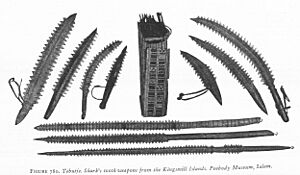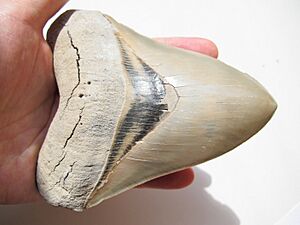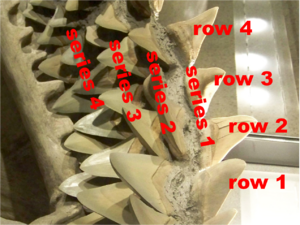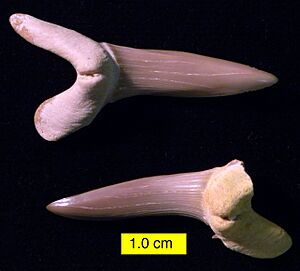Shark tooth facts for kids
Sharks are amazing creatures that are always growing and replacing their teeth. Some sharks, like those in the Carcharhiniformes group, can shed about 35,000 teeth in their lifetime! When a tooth falls out, a new one is ready to take its place.
There are four main types of shark teeth: flat and dense, long and pointy (needle-like), pointy on the bottom with triangle-shaped ones on top, and tiny ones that aren't used for eating. The kind of teeth a shark has depends on what it eats and how it catches its food.
Sharks are great animals to study because they constantly make new, strong teeth. This tooth replacement system helps them quickly replace teeth that get damaged while hunting. Young sharks can even replace their teeth every week! How fast they replace teeth can depend on things like water temperature. Warmer water makes teeth grow faster, while colder water slows it down for sharks like nurse sharks. Teeth only fall out when new ones form underneath and push them out.
A shark's gender can also affect its teeth. This is called sexual heterodonty. Female sharks often have larger teeth because they are usually bigger than males. Also, a shark's age can change its tooth shape. Young sharks have narrower, stronger teeth, while adult teeth are wider and thinner.
Shark teeth are often found as fossils. These fossils can tell us a lot about how sharks have changed over time (evolution) and how they live (biology). Often, shark teeth are the only part of a shark that turns into a fossil because they are made of strong calcium phosphate. The oldest shark-like fish fossils are from 450 million years ago, known mostly from their teeth. But most fossil shark teeth found today are from the last 66 million years.
Contents
Different Types of Shark Teeth and What They Do
Sharks have many different ways of living and eating, and their teeth show this! Their teeth come in many shapes and sizes, each designed for a special job.
Here are some common types of shark teeth, based on what the shark eats:
Dense Flattened Teeth
Sharks with dense, flat teeth use them to crush hard prey like clams and crabs. You can find these sharks, such as nurse sharks and angel sharks, usually living on the ocean floor.
Needle-like Teeth
This was one of the first types of shark teeth to appear, about 400 million years ago. Sharks with needle-like teeth eat small to medium-sized fish, and sometimes even small sharks. These teeth are perfect for gripping slippery, narrow bodies. Modern examples include the blue shark and bull sharks. They use these teeth to catch small prey like squid, flounder, stingrays, and even hammerhead sharks.
Pointed Lower Teeth and Triangular Upper Teeth
This mix of pointy lower teeth and triangle-shaped upper teeth is great for cutting up large animals like big fish and mammals. The upper teeth have jagged edges (serrations) that help them slice big prey into smaller pieces that are easier to swallow. The most famous shark with these teeth is the great white shark. It eats animals like sea lions, dolphins, other sharks, and even small whales.
Non-functional Teeth
Some sharks, like the basking shark and whale shark, eat tiny organisms called plankton. Their teeth are very small and not used for eating at all! These sharks are "filter feeders." They open their mouths wide and swim, letting tiny food get sucked in. They filter the food from the water using special structures in their gills. Basking sharks can eat hundreds of pounds of zooplankton every day! Whale sharks use special rakers on their gill bars to strain krill and other tiny prey from the water.
Transitional Teeth
Sometimes, when one shark species slowly changes into another over a very long time, their teeth can be a mix of both types. For example, teeth from an ancient shark called Otodus auriculatus as it changed into O. angustidens can be hard to tell apart.
Another example is how the extinct giant mako shark, Isurus hastalis, changed into the great white shark, Carcharodon carcharias. Scientists have found teeth that seem to show this change. These teeth look like the wider, flatter teeth of the giant mako, but they also have faint, fading serrations (jagged edges) near the root. Great white sharks have serrations, but giant makos did not.
Special Mention: Megalodon Teeth
The teeth of Otodus megalodon are the biggest of any shark, living or extinct! They are some of the most wanted shark teeth in the world. This huge shark lived about 28 to 1.5 million years ago. It could grow up to 60 feet long! The smallest Megalodon teeth are about 1.2 cm (0.5 in) tall, while the largest can be over 17.7 cm (7.0 in). Teeth that are 3.5 to 4.5 inches are common, but teeth over 5, 6, or 7 inches are very rare. Collectors and investors really want these large teeth, and they can cost a lot of money, sometimes as much as $3,000 for a very big one!
Where to Find Fossil Shark Teeth
You can't find shark teeth fossils just anywhere. Like all fossils, shark teeth are preserved in sedimentary rocks after they fall out of the shark's mouth. The type of sediment they are found in helps scientists figure out how old the tooth is. Most fossil shark teeth are found from the Upper Cretaceous and Tertiary periods. A shark tooth needs about 10,000 years to turn into a fossil. The fossil teeth you find are usually not white because they are covered by the sediment that protected them from decaying.
Fossilized shark teeth are often found near river banks, in sand pits, and on beaches. These teeth are usually worn down because they have been moved around a lot over time. But in some places, you can find perfect teeth that haven't moved much. These can be fragile, so you need to be careful when digging them up. Places with lots of phosphate or kaolin (types of clay) are great for finding fossil shark teeth. One famous place is called Bone Valley in Central Florida, where many teeth found are 3 to 10 million years old. In Georgia, shark teeth are found so often that they became the official state fossil in 1976!
How Shark Teeth are Counted
When scientists count shark teeth, they look at two things: rows and series.
- Rows are counted along the jawline, from side to side.
- Series are counted from the front of the jaw inwards.
A single tooth row has one or more teeth that are currently being used at the front, plus many replacement teeth behind them. For example, a bull shark can have 50 rows of teeth in 7 series! Most sharks have about 15 rows of teeth in each jaw and five series. The small teeth where the two halves of the jaw meet are usually counted separately. Sharks can lose at least one tooth every week, but thanks to their special arrangement, a lost tooth can be replaced within a day!
Learning from Shark Teeth
Scientists can identify most sharks by looking at their tooth counts and shapes. Teeth can even help identify specific shark species, like the requiem shark. Fossilized teeth show us how sharks have changed over millions of years. Even single teeth can be studied to learn about a shark's size and how it moved.
It can be tricky to study fossil teeth because they are often found mixed up and scattered. But new technology, like studying mtDNA (a type of genetic material) from shark jaws and teeth, helps scientists learn about shark populations. Scientists also study the fluorine in shark teeth to understand how sharks avoid cavities. Each tooth has a strong outer layer called enameloid. By studying this layer, we can learn a lot about how sharks eat, how they have evolved, and how their teeth work. This helps us identify different teeth and even the shark species they came from.
History of Discovering Shark Teeth
The first known records of fossilized shark teeth were by a Roman writer named Pliny the Elder. He lived a long time ago and thought these triangle-shaped objects fell from the sky during lunar eclipses!
During the Renaissance (a period in European history), people found large, triangle-shaped fossil teeth stuck in rocks. They believed these were the petrified (turned to stone) tongues of dragons and snakes! So, they called them "tongue stones" or "glossopetrae." In Malta, where many of these teeth are found, people linked them to a legend about Saint Paul. They believed he took away the venom from the island's snakes, and these teeth were called "Saint Paul's tongue." People even thought these "tongue stones" could cure poisons and snake bites. Many kings and queens wore them as good-luck charms!
But in 1558, a Swiss scientist named Conrad Gessner noticed how similar they looked to shark teeth. Then, in 1611, an Italian scientist named Fabio Colonna showed that these rocks came from living things. Finally, in 1667, a Danish scientist named Nicolaus Steno explained what they were made of. He even drew a picture of a shark's head with these teeth! He wrote about his findings in a book called The Head of a Shark Dissected, which also had a drawing of a C. megalodon tooth, which people had thought was a tongue stone.
How Humans Used Shark Teeth

In places like Oceania and America, people often used shark teeth to make tools. They put them on weapons like clubs and daggers. They also used them as blades to carve wood and prepare food, like the māripi used by the Māori. For example, the Native Hawaiians used weapons with shark teeth edges, which they called leiomano. Some special types were only for royalty. The Guaitaca people in Brazil even put shark teeth on the tips of their arrows.
Scientists have found shark tooth weapons and fake shark teeth made of stone in the Cahokia mounds, which are far from the ocean. This shows that these teeth were traded over long distances. It's also said that the rongorongo tablets from Easter Island were carved using a shark tooth attached to a handle.
See also
- Elasmobranch
- Fish jaw
- List of sharks









